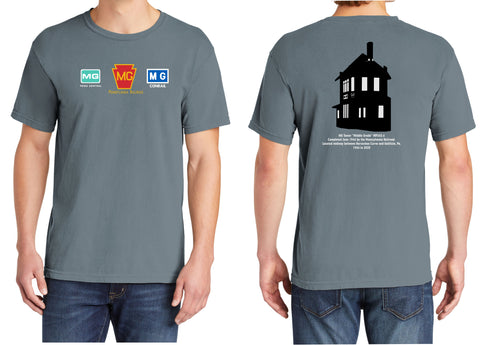
Cleveland Cliffs Iron Company Shirt
Cleveland Cliffs Iron Company Shirt
- Logo Printed on Front
- 100% Cotton Gildan 6.1 oz
- Shirt Color - Metro Blue
The firm's earliest predecessor was the Cleveland Iron Mining Company, founded in 1847 and chartered as a company by Michigan in 1850.[6] Samuel Mather and six Ohio-based associates had learned of rich iron-ore deposits recently discovered in the highlands of the Upper Peninsula of Michigan. Soon afterwards, the first Soo Locks opened in 1855, allowing iron ore to be shipped from Lake Superior to Lake Erie.
Technological improvements, such as the Bessemer furnace, made it possible for the North American Great Lakes to produce steel on an industrial scale. The south shore of Lake Erie was close to a supply of coal, making that region an efficient point for the construction of steel mills.
The final decades of the 19th century were a period of business consolidation from the partnership-sized businesses of an earlier generation to a new type of business firm, the stock-market-traded corporation intent on maximizing market share. The former Cleveland Iron Mining Co. was a survivor of this shakeout, purchasing many of its competitors. One key merger in 1890, with Jeptha Wade's Cliffs Iron Company led the combined firm to change its name to the Cleveland-Cliffs Iron Company.
The consolidated Cleveland-Cliffs invested substantial sums in operations to improve the logistics of iron-ore transport. In 1892, the firm built the Lake Superior and Ishpeming Railroad to carry iron ore from the mines directly to company-owned docks on Lake Superior.
20th century[edit]
William G. Mather, the son of Samuel, guided Cleveland-Cliffs as president and later as chairman of the board during the period of 1890–1947, participating in the transition from the hard-rock iron ore of Upper Michigan to the soft hematite of Minnesota's Mesabi Range and adjacent lodes.
Under Mather, Cleveland-Cliffs was a leader in the development of the classic-type lake freighter, a bulk-cargo vessel especially designed to carry Great Lakes commodities. The 618-foot-long (188 m) William G. Mather, launched in 1925, is a surviving example of this ship type. For almost a century, the black-hulled Cleveland-Cliffs ships were familiar sights on the upper lakes.
Demand for American iron ore hit peaks during World War I, World War II, and the post-WWII consumer boom. In 1933, Edward Greene (the son-in-law of Jeptha Homer Wade II) replaced William G. Mather as the head of the company. The Mather A Mine opened in the early 1940s and the Mather B shaft in the 1950s. As the Cold War continued, reserves of mineable hematite dwindled in northern Minnesota and Cleveland-Cliffs returned some of its focus to its traditional areas of interest around Marquette, Michigan, where new deposits of magnetite were opened. The first pellet plant was built at Eagle Mills in 1954, followed by the first grate/kiln plant at the Humboldt Mine in 1960. The Republic Mine was converted from a shaft mine to an open pit and concentrator in 1956 and a two-kiln pellet plant was added in 1962. The Empire Mine opened in 1963 and was expanded in the mid- and late-1970s; the Pioneer Pellet Plant was opened in 1965 to pelletize the underground ore from the Mather B Mine in Negaunee. In 1974 the Tilden Mine opened in Ishpeming. This mine was and is the only mine in the world with the ability to produce both hematite and magnetite pellets.
In 1970, a high-grade iron-ore mine was opened at Pannawonica in the Pilbara region of Western Australia, with a 200-kilometre (120 mi) rail line to processing facilities at Cape Lambert for which the residential township of Wickham was built. A pellet plant was built but ceased operation before 1980, following a sharp increase in the cost of diesel fuel.
During the 1970s, Cleveland-Cliffs had sizeable interests in uranium and shale oil fields, as well as the oil and gas drilling industries. It also had holdings in the forest products industry. This interests were disposed of in the 1980s when the company refocused its efforts on its core iron ore business.[7]
The periods following the recessions of 1974–75 and 1981–83 were harsh ones for the iron ore industry. Cleveland-Cliffs shrank its operations, closing the Mather B Mine and the Pioneer Pellet Plant and associated Ore Improvement Plant in 1979. The Humboldt Pellet Plant closed in 1981 and the Republic Mine was idled in 1981 and closed for good in 1996, when Cliffs began turning the associated tailings ponds into compensatory wetlands for its other properties. Over half of the Marquette Iron Range employees were laid off and, in 1984, Cliffs withdrew from the Great Lakes shipping industry.
Please allow 10 business days to ship.




